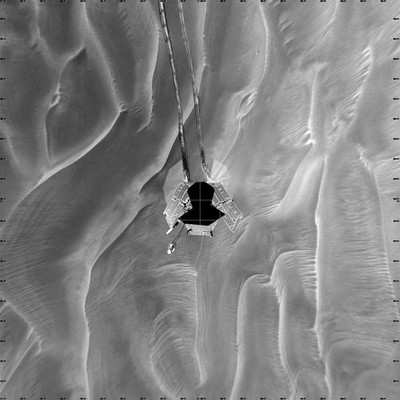Martian Robot Still Making Discoveries After Seven And A Half
Years
The initial work of NASA's Mars rover Opportunity at its new
location on Mars shows surface compositional differences from
anything the robot has studied in its first 7.5 years of
exploration. Opportunity arrived three weeks ago at the rim of a
14-mile-wide (22-kilometer-wide) crater named Endeavour. The first
rock it examined is flat-topped and about the size of a footstool.
It was apparently excavated by an impact that dug a crater the size
of a tennis court into the crater's rim. The rock was informally
named "Tisdale 2."
NASA Image From Opportunity

"This is different from any rock ever
seen on Mars," said Steve Squyres, principal investigator for
Opportunity at Cornell University in Ithaca, N.Y. "It has a
composition similar to some volcanic rocks, but there's much more
zinc and bromine than we've typically seen. We are getting
confirmation that reaching Endeavour really has given us the
equivalent of a second landing site for Opportunity."
The diversity of fragments in Tisdale 2 could be a prelude to
other minerals Opportunity might find at Endeavour. In the past two
weeks, researchers have used an instrument on the rover's robotic
arm to identify elements at several spots on Tisdale 2. Scientists
have also examined the rock using the rover's microscopic imager
and multiple filters of its panoramic camera.
Observations by Mars orbiters suggest that rock exposures on
Endeavour's rim date from early in Martian history and include clay
minerals that form in less-acidic wet conditions, possibly more
favorable for life. Discontinuous ridges are all that remains of
the ancient crater's rim. The ridge at the section of the rim where
Opportunity arrived is named "Cape York." A gap between Cape York
and the next rim fragment to the south is called "Botany Bay."
"On the final traverses to Cape York, we saw ragged outcrops at
Botany Bay unlike anything Opportunity has seen so far, and a bench
around the edge of Cape York looks like sedimentary rock that's
been cut and filled with veins of material possibly delivered by
water," said Ray Arvidson, the rover's deputy principal
investigator at Washington University in St. Louis. "We made an
explicit decision to examine ancient rocks of Cape York first."
Opportunity Seen From Mars
Orbiter

The science team selected Endeavour as Opportunity's long-term
destination after the rover climbed out of Victoria crater three
years ago this week. The mission spent two years studying Victoria,
which is about one twenty-fifth as wide as Endeavour. Layers of
bedrock exposed at Victoria and other locations Opportunity has
visited share a sulfate-rich composition linked to an ancient era
when acidic water was present. Opportunity drove about 13 miles (21
kilometers) from Victoria to reach Endeavour. It has driven 20.8
miles (33.5 kilometers) since landing on Mars.
"We have a very senior rover in good health for having already
worked 30 times longer than planned," said John Callas, project
manager for Opportunity at NASA's Jet Propulsion Laboratory (JPL)
in Pasadena, Calif. "However, at any time, we could lose a critical
component on an essential rover system, and the mission would be
over. Or, we might still be using this rover's capabilities
beneficially for years. There are miles of exciting geology to
explore at Endeavour crater."
Opportunity and its rover twin, Spirit, completed three-month
prime missions in April 2004 and continued working for years of
extended missions. Both have made important discoveries about wet
environments on ancient Mars that may have been favorable for
supporting microbial life. Spirit ended communications in March
2010. NASA will launch its next-generation Mars rover, Curiosity,
between Nov. 25 and Dec. 18, 2011. It will land on Mars in August
2012. JPL manages the Mars Exploration Rover Project for NASA's
Science Mission Directorate in Washington.
 ANN's Daily Aero-Linx (04.16.24)
ANN's Daily Aero-Linx (04.16.24) Aero-News: Quote of the Day (04.16.24)
Aero-News: Quote of the Day (04.16.24) Airborne 04.10.24: SnF24!, A50 Heritage Reveal, HeliCycle!, Montaer MC-01
Airborne 04.10.24: SnF24!, A50 Heritage Reveal, HeliCycle!, Montaer MC-01 Airborne 04.12.24: SnF24!, G100UL Is Here, Holy Micro, Plane Tags
Airborne 04.12.24: SnF24!, G100UL Is Here, Holy Micro, Plane Tags Airborne-Flight Training 04.17.24: Feds Need Controllers, Spirit Delay, Redbird
Airborne-Flight Training 04.17.24: Feds Need Controllers, Spirit Delay, Redbird




